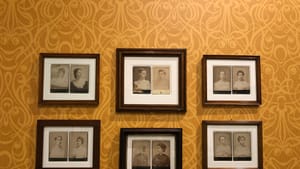Stay in the Loop
BSR publishes on a weekly schedule, with an email newsletter every Wednesday and Thursday morning. There’s no paywall, and subscribing is always free.
The age of the asylum
The Library Company of Philadelphia presents Hearing Voices: Memoirs from the Margins of Mental Health

There’s a lot to take in at Hearing Voices: Memoirs from the Margins of Mental Health, a new exhibition at the historic Library Company of Philadelphia, featuring “insanity narratives” from people committed to 19th-century asylums. The press release calls it “a story of mental health in America,” but that’s a bit of a misnomer. The bigger story here, which these archives allude to but cannot fully explore, is society’s ongoing willingness to imprison anyone we deem as “other.”
As an introductory placard notes, the documents displayed (including the asylums’ own materials, doctors’ treatises, and patient narratives) are rife with bigoted views that the Library Company disavows today, but are necessary to curate for historical understanding.
Creative imprisonment
For anyone who’s experienced abuse, sexual assault, racism or sexism or ableism, or even a modern psychiatric hospitalization, the show warrants a hefty content warning. But it also spotlights the resilience and creativity of people who encountered asylums. Many of the individuals whose work is displayed here, in a variety of published tracts, books, poetry, and artwork, did not walk, but ran to tell their stories.
Take Isaac Hunt, who, a mere two days after his release from the Maine Insane Hospital in 1848, was at the state house petitioning for redress. He published Astounding Disclosures! Three Years in a Mad House in 1851, on display here. Or take Illinois housewife Elizabeth Packard. After her husband had her committed to the Jacksonville Insane Asylum for three years with the help of a doctor who disguised himself as a sewing-machine salesman to gain access to her at home, she emerged to find that hubby had taken all of her property and custody of their children (all entirely within the law in 1860). She promptly formed the Anti-Insane Asylum Society and became a lifelong activist for the rights of married women and “mental health reform.”
It makes you wonder whether being imprisoned for mental illness is a crucible for lyrical determination, or whether people targeted for this kind of treatment already possess the observant, creative, and outspoken qualities that make people in power nervous.
Race and gender in the asylum
Curators Rachel D’Agostino and Sophia Dahab, with an exhibition layout that separates the asylum experiences by the patients’ gender and race, seem to acknowledge that historically, incarceration in asylums had less to do with mental illness and more to do with who you were.
Male patients whose works are included in the show came to asylums for reasons like alcoholism, crime, or “a spate of erratic behavior” (John Thomas Percival, 1803-1876). But the women? Reasons given for their institutionalization include religious conversion, working in labor reform, advocating for sanitation with civic authorities, protecting children from domestic abuse, and reporting rape.
Of course, “hysteria” and the “rest cure” feature as well, as immortalized by Charlotte Perkins Gilman’s 1899 The Yellow Wallpaper, an early printing of which is on display here. Nearby is a set of 12 photos, before-and-after portraits of six English women who underwent a rest cure at the hands of Dr. William Playfair in the 1880s, the angles of their faces softening into curves—not a surprising outcome of a treatment described as over-feeding patients while forcing them out of “all possible use of brain and body.”
These portraits are displayed against a florid yellow wallpaper designed for the exhibition by Tiffany Weiser (after E.B. Bird’s 1899 original). It does indeed swim with dangling bulbs, unnerving faces, and what might be the figure of a woman bulging within the ornate lines.
The exhibition’s gender-divided layout points to the way misogyny operates on our very notions of mental illness. While women routinely endure labels like “crazy” or “psycho” simply for existing in public, men who commit mass murder receive shelter and exoneration in the label “mentally ill.”
Another vitrine display highlights stories of Black or Indigenous or immigrant people in asylums, alongside the theories of anti-abolitionist doctors who preached that ending slavery would make Black people insane. These marginalized people did not have the means to publish or preserve their stories like white men and women did, and so we often lack first-hand documentation of their experiences. “The absence of evidence is not the evidence of absence,” the museum notes.
More than a window on the past
Hearing Voices traces the history of medical philosophy and practice relating to mental illness—from “moral therapy” (which incorporated exercise, socialization, and work into recovery programs) to forced sterilization to water torture and gruesome restraints. And it details the enduring shame of the asylum: as Margaret Starr wrote in her book Sane or Insane, or, How I Regained My Liberty (1904), “I often wonder how it will be when I regain my liberty, and I realize that there will be fixed on me the stigma of the Mad House.”
But don’t mistake this asylum-themed archive for a mere window on the past. This tightly focused exhibition does not allude to the modern criminal justice system, but across the US today, there are more people with serious mental illness (including schizophrenia and bipolar disorder) in jails and prisons than in psychiatric hospitals. Mentally ill people, many of whom encounter brutal policing and sentencing rather than treatment, often experience longer prison stays and punishments that only worsen their symptoms.
This means the 21st century is still very much the age of the asylum, by many newer names. These practices continue beyond our prison system, from deadly 19th and 20th-century assimilationist “residential schools” which ripped Indigenous children from their communities, to the separation and incarceration of immigrant and refugee families that continue in the US today.
People with mental illness join a long list of “others” to be forcibly detained, and Hearing Voices is one thread of that story. As in any movement that uncovers systemic injustice, the voices that emerge here speak the unspeakable—until we start to listen together.
“But oh! tongue cannot tell nor pen describe what I suffered,” writes Moses Swan in his 1874 book, Ten Years and Ten Months in Lunatic Asylums in Different States. “But to my story…”
What, When, Where
Hearing Voices: Memoirs from the Margins of Mental Health. Through December 22, 2022 at the Library Company of Philadelphia, 1314 Locust Street, Philadelphia. The show is free and open to the public. (215) 546-3181 or librarycompany.org.
All Library Company visitors must present proof of Covid-19 vaccination, and wear a mask in the building (masks are provided for guests who need them).
Accessibility
The Library Company is a wheelchair-accessible building with gender-neutral restrooms. Anyone who requires additional accessibility info or support can call (215) 546-3181 x144, or email [email protected].
Sign up for our newsletter
All of the week's new articles, all in one place. Sign up for the free weekly BSR newsletters, and don't miss a conversation.
 Alaina Johns
Alaina Johns